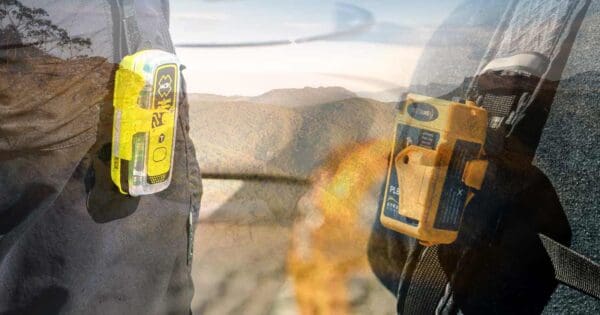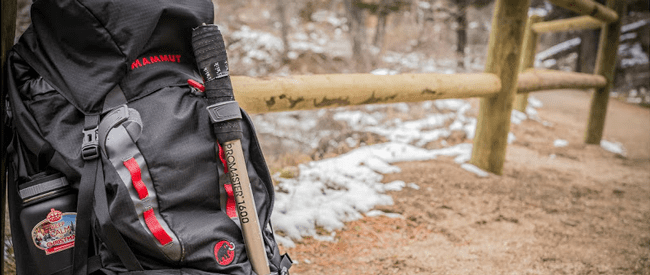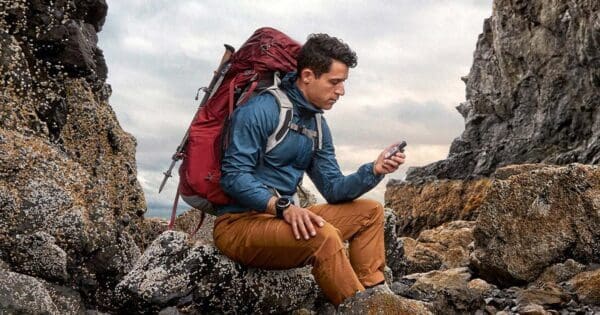Why post-downpour hikes might be more than they seem
Australia’s diverse landscapes offer breathtaking hiking trails, from lush rainforests to sun-drenched coastal paths. But what happens when that sun disappears behind heavy rain clouds and the earth glistens with the fury of recent downpours? While the allure of cascading waterfalls and verdant trails might be tempting, venturing out after heavy rain can pose significant dangers that go beyond a simple slip on a muddy track.
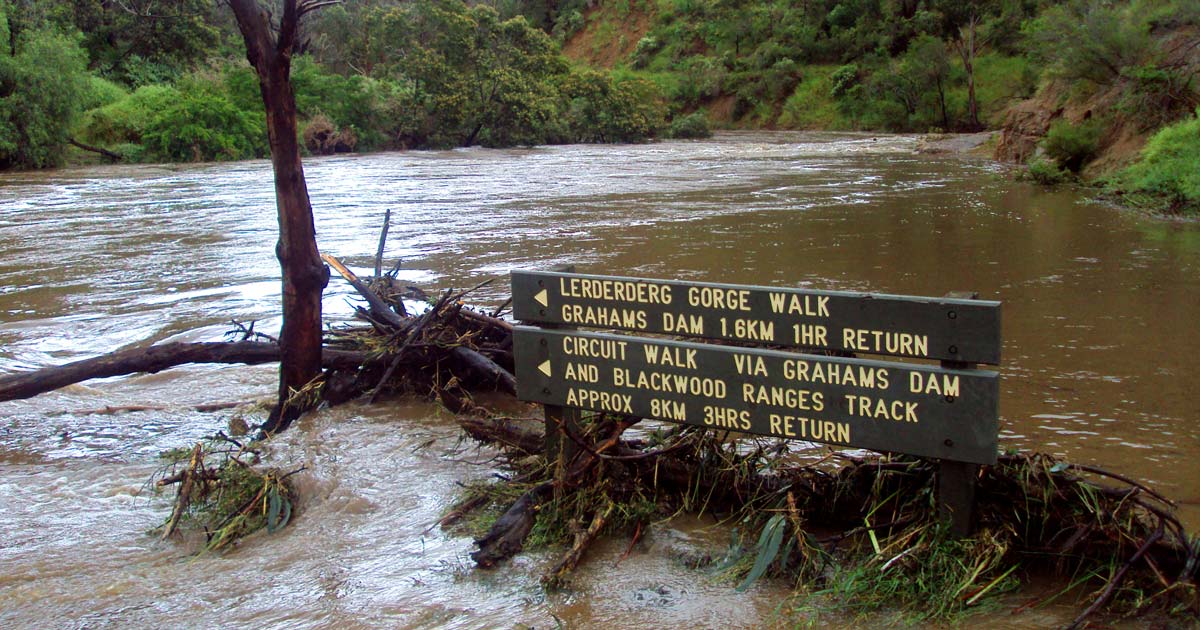
Crossing the Raging River
Swollen rivers are one of the most immediate threats. Usually gentle streams can transform into raging torrents, easily sweeping away unsuspecting hikers. Even seemingly shallow crossings can hide powerful currents, and underestimating the force of water can have tragic consequences.
Imagine this: you’re traversing a familiar hiking trail, the air crisp and clean after a refreshing downpour. The babbling creek you crossed countless times before is now a churning torrent, its once gentle gurgle replaced by an ominous roar. This is the deceptive allure of swollen rivers, one of the most immediate and deadly threats posed by hiking after heavy rain in Australia.
Underestimating the power of raging rivers is a recipe for disaster. What appears to be a shallow crossing can mask powerful currents, capable of sweeping even the most experienced hiker off their feet. These hidden dangers lurk beneath the deceptively calm surface, waiting to pounce on the unwary.
The Treacherous Depths:
- Hidden Currents: The force of rushing water can carve out deep channels and eddies, creating invisible pockets of turbulence that can pull a hiker underwater in a heartbeat.
- Debris Dangers: Flash floods and heavy rain often carry debris like logs, branches, and rocks. These can collide with unsuspecting hikers, causing injury or even knocking them unconscious, making them even more vulnerable to the current.
- Underwater Obstacles: Flooded rivers can obscure rocks, logs, and other obstacles that could cause a stumble or trip, sending a hiker tumbling into the raging water.
The Consequences of Miscalculation:
A single misstep near a swollen river can have tragic consequences. Hikers who are swept away by the current face a multitude of dangers:
- Hypothermia: The cold water can rapidly sap body heat, leading to hypothermia, even in warm weather.
- Drowning: The force of the water can make it difficult to stay afloat, especially for those not wearing proper life jackets or lacking swimming skills.
- Injury: Collisions with debris or underwater obstacles can cause serious injuries, further increasing the risk of drowning.
Safety First: Essential Tips for Crossing Rivers:
If you absolutely must cross a river after heavy rain, here are some essential tips to keep in mind:
- Never attempt to cross a flooded or raging river. It’s simply not worth the risk.
- Look for established crossing points. These are often marked by bridges or well-worn paths and are generally safer than attempting to cross elsewhere.
- Check the water depth and flow. Use a stick or branch to measure the depth and assess the current’s strength. If it’s too deep or fast, turn back.
- Travel with a buddy. Having someone with you can provide assistance if you fall or get swept away.
- Wear proper gear. Wear sturdy shoes with good traction and a life jacket if available.
- Carry a communication device. A waterproof phone or satellite communicator can be invaluable in case of emergencies.
Remember, the beauty of Australia’s natural landscapes should never come at the cost of your safety. By respecting the power of raging rivers and exercising caution, you can ensure your next post-rain adventure is one of awe-inspiring beauty, not heartbreaking tragedy.
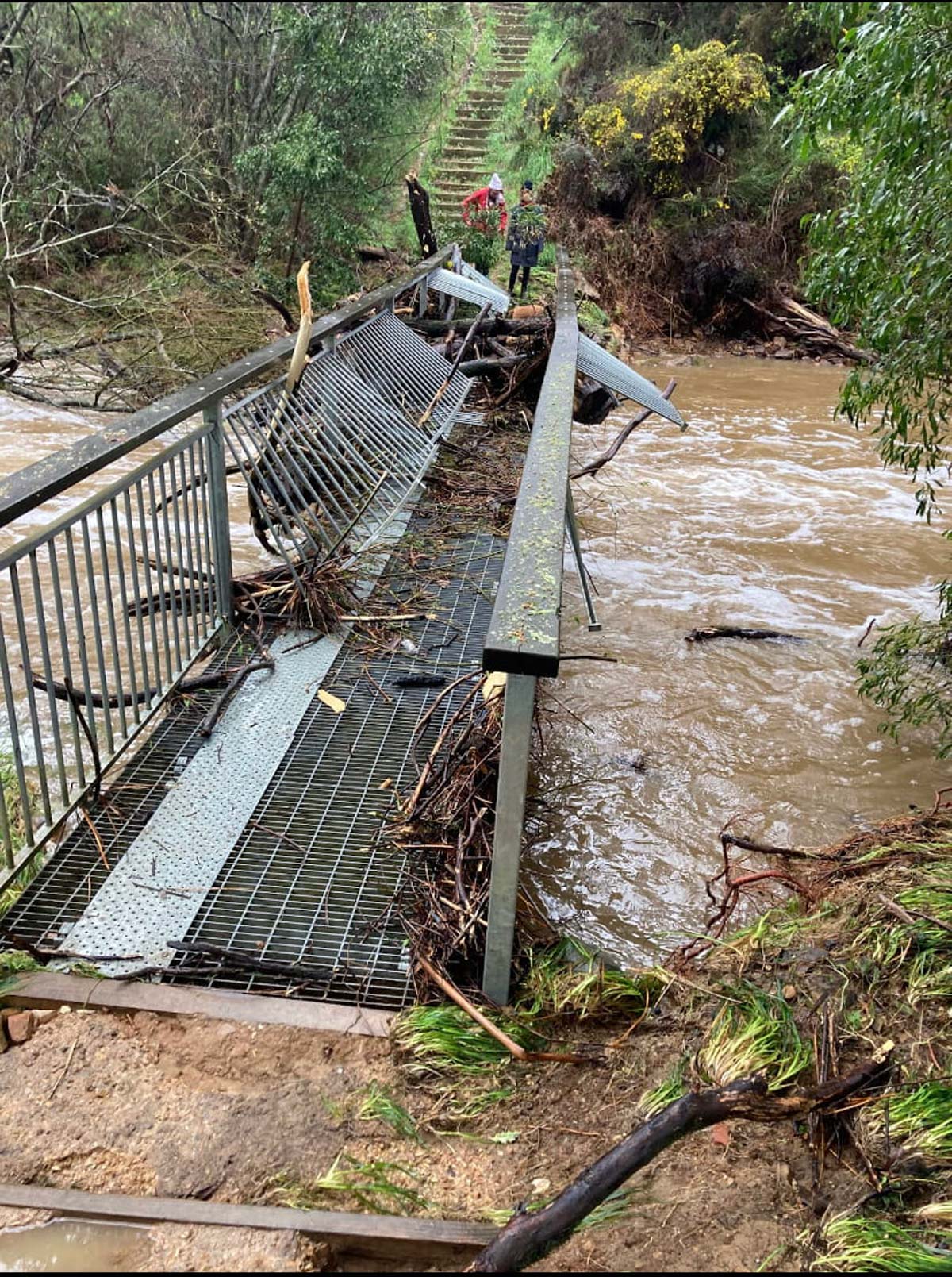
Flash Floods
The aftermath of a heavy downpour might paint a picture of a gentle rejuvenation. Lush greenery emerges, waterfalls roar with renewed vigor, and creeks gurgle merrily. But beneath this picturesque veneer lies a hidden predator: the flash flood.
These sudden surges of water are not to be underestimated. In a matter of minutes, seemingly dry creek beds can morph into raging torrents, transforming familiar paths into treacherous waterways. Their deceptiveness lies in their speed and unpredictability. One moment you’re admiring a glistening rock pool, the next you’re battling against a wall of muddy water carrying debris like battering rams.
The Deceptive Lull: Sunshine after rain often masks the danger lurking downstream. Dry sections of a creek bed don’t guarantee the entire path is safe. Water can travel miles, unseen and unheard, until it bursts forth in a concentrated surge.
Well-known trails and crossings become unrecognisable when inundated. Landmarks disappear, and familiar paths become a maze of rushing water and swirling debris.
The speed and force of a flash flood are its most frightening aspects. Imagine this:
- A seemingly harmless trickle can transform into a towering wave, sweeping away anything in its path. Hikers caught unaware can be easily knocked off their feet and dragged downstream.
- Flash floods carry along a deadly cocktail of debris – logs, rocks, branches – transforming them into battering rams that can injure or even crush unfortunate bystanders.
- Rushing water obscures the true depth and terrain beneath the surface. What appears shallow can hide deep pockets and sudden drop-offs, leading to unexpected dangers.
The “If It’s Flooded, Forget It!” Mantra:
- The key to surviving a flash flood is simple: avoid it at all costs.
- Never attempt to cross flooded terrain. Even seemingly shallow water can be deceptively powerful.
- Turn back, retreat, seek higher ground. Do not hesitate to change your plans and find safety, even if it means abandoning your original route.
- Monitor weather reports and warnings. Stay informed about potential flash flood risks in the area before and during your hike.
Remember, the thrill of adventure should never come at the cost of your safety. By respecting the power of flash floods and following the “If It’s Flooded, Forget It!” mantra, you can ensure your post-rain journey is one of breathtaking beauty, not a terrifying encounter with nature’s hidden fury.
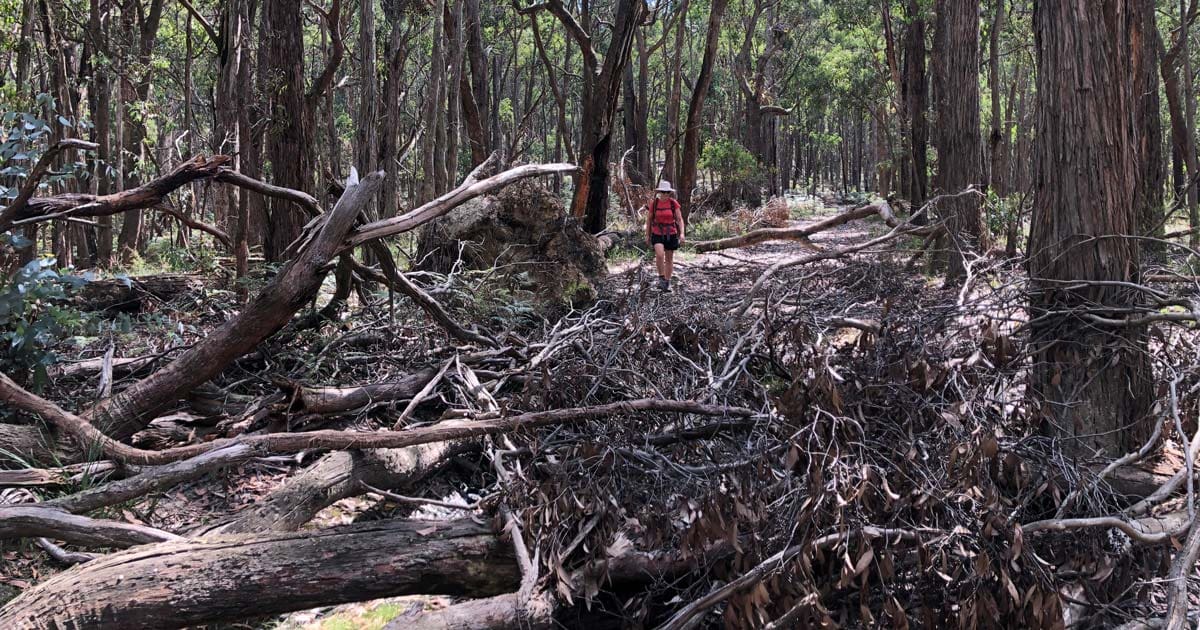
The Risk of Tree Falls
Australia’s landscapes are adorned with towering trees, from the majestic gums to the delicate wattles. They offer shade, shelter, and beauty, but in the aftermath of heavy rain, these arboreal giants can transform into silent sentinels of danger. Why? Rain’s subtle touch weakens the soil, making trees, particularly the ubiquitous eucalypts, vulnerable to toppling, snapping, and showering unsuspecting hikers with debris.
Roots on Shaky Ground:
- Saturated Soil: Rain loosens the grip of the earth, turning once-firm soil into soggy mush. Imagine tree roots anchoring in quicksand – their hold weakened, their resistance to wind and gravity compromised.
- Shallow Root Systems: Eucalypts, adapted to arid conditions, often have shallow roots compared to deeper-rooted counterparts. This shallow anchorage makes them particularly susceptible to wind gusts and soil erosion, especially on slopes.
The Dance of Wind and Wood:
- High Winds: After a downpour, strong winds become an unwelcome partner. They act as battering rams, pushing against weakened trees, and can easily snap branches or even uproot entire giants, sending them crashing down with devastating force.
- Dead and Diseased Trees: Heavy rain and wind can also expose pre-existing weaknesses in trees, like internal rot or dead branches. These vulnerabilities become conduits for failure, turning seemingly healthy trees into sudden threats.
The Silent Victims:
- Falling Branches: Even without complete tree falls, heavy rain can loosen limbs, sending them plummeting like missiles from the canopy. These can cause serious injuries, especially to unsuspecting hikers underneath.
- Sudden Topples: The weakened soil and strong winds can cause a tree to fall with alarming speed, leaving little time for reaction. Hikers venturing too close to trees are at particularly high risk.
Staying Safe in the Bush Post-Rain:
- Maintain Distance: Avoid walking directly under trees, especially during or after heavy rain and strong winds. Give them a wide berth, respecting their potential to become falling hazards.
- Open Areas over Forest Cover: Opt for open areas over densely wooded sections, minimising the risk of being struck by falling branches or uprooted trees.
- Heed Weather Warnings: Stay informed about weather alerts and forecasts. If high winds or severe storms are predicted, postpone your hike until the danger subsides.
- Broken Branches as a Red Flag: Look for signs of tree damage, like broken branches or cracks in the trunk. These signal potential instability and warrant a cautious detour.
Remember, the allure of the green after rain should not eclipse caution. By respecting the silent danger lurking in weakened trees, you can transform your post-rain hike into a safe and rewarding adventure in Australia’s magnificent natural tapestry.
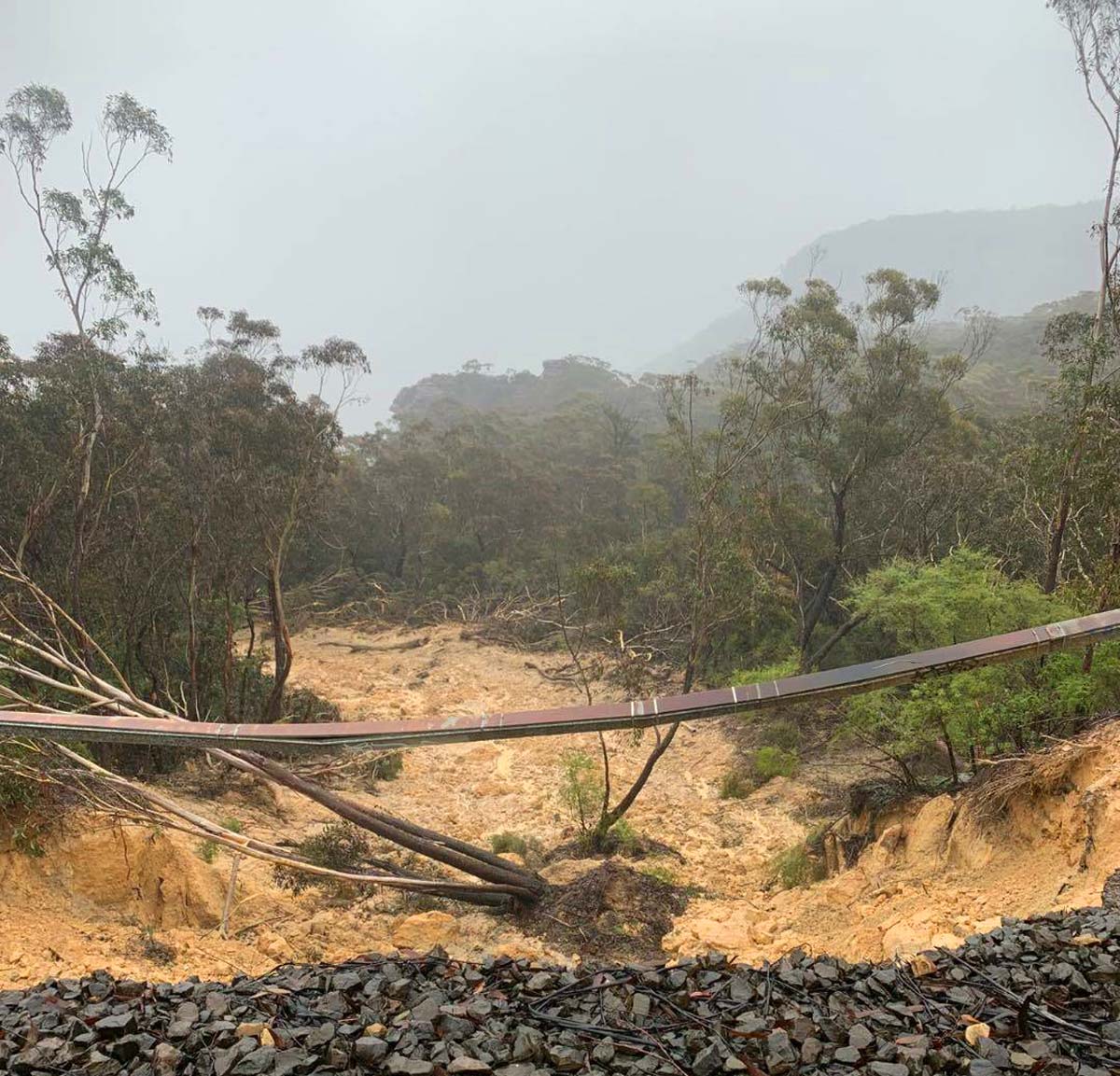
Landslides: When the Earth Gives Way
Imagine this: you’re traversing a scenic mountain trail, the aroma of damp earth and pine filling your lungs. But beneath the idyllic surface, a silent drama unfolds. Rain has saturated the soil, transforming it from a solid grip to a slippery slurry. Suddenly, the earth groans, cracks appear like lightning scars, and with a heart-stopping rumble, a section of the slope gives way. This is the terrifying reality of landslides – a post-rain hazard that can transform a peaceful hike into a life-threatening ordeal.
Why are landslides so dangerous after rain? Here’s the science:
- Saturated Soil: Heavy rain acts like a giant sponge, soaking up the earth until it reaches its saturation point. This saturated soil loses its stability, becoming loose and prone to slipping.
- Erosion and Undercutting: Rainwater can also erode the base of slopes, undermining their support and creating a precarious imbalance. Imagine a sandcastle slowly losing its base – the same principle applies to hillsides.
- Steep Slopes and Cliffs: These are particularly vulnerable to landslides, as gravity exerts a stronger pull on the already-loose soil. The steeper the slope, the higher the risk.
Landslides come in various forms, each posing its own unique threat:
- Rockfalls: Sudden tumbles of large boulders and rocks, often triggered by vibrations or weakened cliffs. Imagine a cascading pile of boulders, leaving no room for escape.
- Debris Flows: Fast-moving mixtures of mud, rock, and vegetation, sweeping down slopes like deadly rivers of mud. Picture a churning torrent of mud and debris engulfing everything in its path.
- Earth Slumps: Gradual slides of large sections of land, often accompanied by cracks and bulges in the soil. Think of a slow-motion collapse of the earth, swallowing anything in its wake.
The consequences of encountering a landslide can be devastating:
- Direct Impact: Hikers caught in the path of a landslide can be crushed by falling debris, swept away by mudflows, or buried alive.
- Blocked Trails: Landslides can block trails, leaving hikers stranded or forcing them to take potentially dangerous detours.
- River Diversions: In some cases, landslides can divert the course of rivers, creating unexpected flash flood risks.
Staying Safe on the Slopes:
So how can you stay safe from landslides after rain? Here are some essential tips:
- Avoid Steep Slopes and Cliffs: Choose well-maintained trails on stable ground and steer clear of steep slopes and cliffs, especially after heavy rain.
- Watch for Warning Signs: Be mindful of any signs of potential landslides, such as cracks in the ground, bulging soil, leaning trees, or unusual water runoff.
- Monitor Weather Reports: Stay informed about weather forecasts and warnings. Avoid hiking during or immediately after heavy rain, especially in areas prone to landslides.
- Listen to Your Gut: If something feels off or unsafe, trust your instincts and turn back. It’s always better to be safe than sorry.
Remember, respecting the power of nature and exercising caution on post-rain treks is paramount. By staying vigilant, avoiding risky areas, and prioritising safety, you can ensure your adventures in Australia’s breathtaking landscapes remain memories filled with awe, not despair.
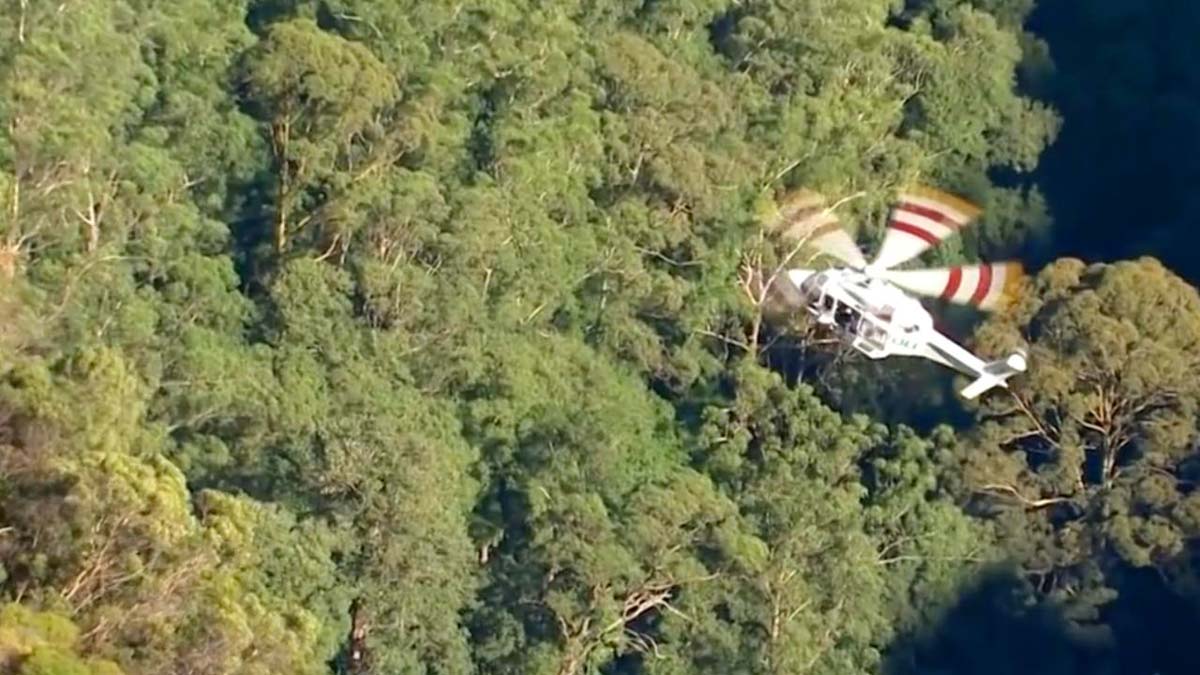
Hindered Heroes
When disaster strikes in the wilderness, every second counts. But after heavy rain, the battle for survival becomes a two-pronged conflict – not just for the injured hiker, but also for the brave men and women who rush to their aid. The once familiar landscape is transformed into a treacherous maze, hindering the crucial efforts of search and rescue teams and potentially putting lives at further risk.
A Labyrinth of Obstacles:
- Flooded Rivers: Raging torrents replace gentle streams, blocking established routes and forcing detours through treacherous terrain. Time-sensitive rescues are delayed, precious minutes ticking by as teams scramble to find safe passage.
- Washed-Out Tracks: Rain-ravaged trails become unrecognisable, washed away or choked with debris. Landmarks disappear, leaving rescuers navigating a confusing maze with limited visibility. Locating the injured becomes a needle-in-a-haystack challenge.
- Obscured Landmarks: Familiar markers and navigational aids vanish under a cloak of mud and debris. Gone are the comforting signposts and reassuring landmarks, plunging rescuers into a disorienting wilderness.
The Cost of Delayed Rescue:
Every lost minute in this post-rain battlefield can have dire consequences:
- Hypothermia: Trapped in the elements, injured hikers can rapidly succumb to hypothermia, even in warm weather. The ticking clock becomes a chilling enemy, and swift rescue is critical.
- Internal Injuries: Untreated internal injuries can worsen with time, increasing the risk of complications and even death. The longer the delay, the higher the stakes.
- Psychological Trauma: The fear and uncertainty of being lost and injured in a hostile environment can inflict deep psychological trauma. Rescuing hikers not only saves lives but also heals minds.
A Shared Responsibility:
By avoiding unnecessary risks after heavy rain, you can become a silent hero yourself:
- Heed Weather Warnings: Pay close attention to weather forecasts and warnings. Avoid venturing out when conditions pose a high risk of disaster.
- Plan and Prepare: Choose well-maintained trails, inform others of your plans, and carry adequate supplies and emergency equipment.
- Respect the Power of Nature: Don’t underestimate the dangers of swollen rivers, landslides, and flash floods. Turn back when faced with uncertainty.
Remember, your responsible choices not only protect yourself but also spare emergency responders a potentially dangerous and arduous mission. By acting with caution and understanding the challenges they face, you can ensure that the heroes of the wilderness have the best chance to reach those in need, even when the rain has turned the landscape against them.
Let’s all strive to be responsible adventurers, not just for our own safety but also for the heroes who stand ready to answer the call when disaster strikes.
Remember, the beauty of Australia’s wilderness deserves respect, and that includes understanding its potential dangers. By being aware of the risks associated with hiking after heavy rain, you can make informed decisions and ensure your next adventure is one to cherish, not mourn. So, the next time the rain clouds gather, consider waiting for the sun to return before lacing up your boots. The trails will be there, and the experience will be all the more rewarding for your patience and prudence.
Main photo: State Emergency Service (SES)
